One of my absolute highlights in South America, the Salar de Uyuni is, without doubt, one of the most remarkable sights on this continent.
Situated high in Bolivia’s altiplano, this flat, expansive otherworldly landscape is truly unforgettable and certainly should not be missed during your trip to this part of the world.
Best accessed by a 4wd, due to its remote and inhospitable terrain, Salar de Uyuni really is best experienced as part of a tour – with even this ardently independent traveller having to admit this really is the ultimate way to see these magnificent salt flats.
So, if you are heading to this part of Bolivia soon, then check out this article for the full lowdown on which sort of tour to take, how to book and organise it, how much to pay, what to pack and a whole heap of other tips drawn from my personal experience of travelling to this wonderful part of the world as a solo female backpacker…
Related Posts
- 55 Best Things To Do in South America
- 21 Best Things to Do in La Paz, Bolivia
- Top 5 Things to Do in Copacabana, Bolivia
This page contains affiliate links meaning Big World Small Pockets may receive a small commission on any purchases at no extra cost to you.
Why Visit Salar de Uyuni?
Bolivia’s Salar de Uyuni is one of the world’s largest salt flats.
The Spanish name for what us English speakers would call the Uyuni Salt Flats, this huge, high altitude landscape, which stretches as far as the eye can see, used to be part of an ancient prehistoric lake.
Drying out over thousands of years, the result we are now left with is almost 11,000 sq km of flat, white, lunar-like territory that looks, quite frankly, like something from another planet!
No surprise therefore that this is one of South America’s most dazzling sights and one of its most visited too.
From comedy photoshoots to epic 4wd drives, jaw-dropping views and the chance to visit a cactus island, Salar de Uyuni is utterly unique in every way.
No question, it’s an absolute bucket list must!
Where is Salar de Uyuni?
Salar de Uyuni is situated in the southern end of the country of Bolivia in South America.
Part of the province of Potosi, and close to both the Argentinian and Chilean borders, Salar de Uyuni is the place many travellers either start or end their time in Bolivia.
This is mainly due to the proximity of the Salt Flats to these international borders; with land crossings to Chile and Argentina both easy and common, many people either arrive into or leave Bolivia from here.
Uyuni is the main Bolivian access town, situated only a short drive from the edge of salt flats, and close to the Chilean border.
Otherwise, Tupiza is the alternative Bolivian jump-off point for the Salar, and is situated slightly further away and closer to the Argentina border.
Learn about how to get to both these destinations later in this post.
Altitude
The other thing to know about the location of the Salar de Uyuni is that this Andean salt flat is situated at quite an altitude!
Yes, located some 3,656m above sea level, this is the sort of place you need to work up to visiting… literally!
Some previous time at altitude (either in the Bolivian highlands, the North of Chile or Northern Argentina) is highly recommended before you attempt to visit Uyuni, where the lack of oxygen in the air at this elevation is bound to make you feel quite unwell if your body isn’t used to it.
You must, ABSOLUTELY MUST, take altitude issues seriously when you come to Salar de Uyuni and spend at least a couple of days acclimatising before taking a tour here.
As an FYI, I’ve had altitude sickness myself in Ecuador and can definitely attest to the fact it is not nice!
Indeed, it can be very serious and sometimes lead to hospitalisation and even death.
Please do not take this issue lightly when travelling to Uyuni and if you start to suffer any symptoms then take the necessary precautions.
You can learn more about altitude sickness, what causes it, what the symptoms are and how to avoid or treat it in this useful article.
When to Visit?
Located at such a high elevation, climate and weather in Salar de Uyuni is always an interesting topic.
A dry, desert-like climate it can be extremely sunny up here with temperatures well over 20 degrees celsius during the day.
But at night, the temperature drops and things can get pretty chilly, pretty quickly – often plummeting to below zero celsius, especially in the coldest months of July and August.
With temperatures always fairly extreme therefore, the main factor in deciding when to take your Uyuni Salt Flat tour is really down to the season, namely the wet or the dry one.
The dry months in Bolivia run from May to October, while the wet season runs from December to March.
In between, during the months of April and November, the weather is in flux and can be either dry or wet!
Most tourists embark on Salar de Uyuni tours during the dry season when the whole area (and country) is very accessible.
Although it can be slightly colder at this time, the days are wonderfully sunny, the skies clear and the visibility across the whole of the salt flats excellent.
During the wet months, on the other hand, transport around this off-road area can prove more difficult and not all parts of the salt flats are accessible.
However, to make up for it, visitors are often rewarded with some incredible reflective views, as the few cms of rain that often sit on top of the Uyuni salt flats, regularly transform it into the world’s largest mirror!
If you take a Salar de Uyuni tour in the shoulder months of either April or November (as I did), then you could be treated to either of these spectacles – not a bad chance to take!
Learn more about when to visit Bolivia as part of these 19 top tips for visiting the country.
Travel Insurance for Bolivia
World Nomads offers simple and flexible travel insurance. Buy at home or while travelling and claim online from anywhere in the world.
Alternatively, if you’re a long-term traveller, digital nomad or frequent remote worker seeking travel health cover, check out Safetywing’s Nomad Insurance policies.
Just enter your details below and I'll email it you - simple!
Information will be sent to the email provided above
The 4 Types of Salar de Uyuni Tours
The first thing to say is that you really should take a tour when you visit the Bolivian salt flats.
A remote and barren environment, which requires a 4wd vehicle, there are some travellers who self-drive this landscape, but the chances of you getting lost and not finding the top spots are high if you chose to go it alone.
Plus you have to be well prepared with gas, food, fuel and water etc.
In line with this, it’s worth knowing that you have a few options when it comes to Salar de Uyuni tours.
Indeed there are 4 main types of tours, which begin from different destinations, have different lengths and include different things.
Here’s an outline of the 4 main types of tours you can enjoy on the Uyuni salt flats…
#1 Longer South America Tour
The first option is to build your Salar de Uyuni tour into part of a larger South American or trip with a reputable company like these ones which offer extended excursions in the region.
Generally speaking, these longer South America tours operate as a packaged trip where you can join a group to visit the top highlights in several countries in the area.
The starting point for this type of Salar De Uyuni tour will depend entirely on where your longer tour starts and finishes, with the options too varied to list here.
#2 Full Bolivia Tour
The second option is to build one of the Salar de Uyuni tours into a longer Bolivia only tour.
Again, several companies organise package Bolivia itineraries that will help you traverse the lengths and breadths of this country as part of a group trip with professional guides and pre-arranged activities and accommodation.
It’s highly likely that building a trip to Salar de Uyuni into a Bolivia-wide tour, like these ones, will begin and end in La Paz and last anything between 1 and 3 weeks.
#3 Uyuni & San Pedro de Atacama Tours
Just across the border from Uyuni in Bolivia is the San Pedro de Atacama desert in Chile and many people combine these 2 attractions together, visiting them as part of the same trip.
In fact, you can actually book tours that incorporate both locations i.e. Uyuni and Atacama as part of a 3 day excursion.
More about this later in this article, but suffice to say, these sorts of Salar De Uyuni tours will either begin in the Bolivian towns of Uyuni, Tupiza or the Chilean destination of Atacama, depending on which direction you’re travelling in.
Such tours normally involve you joining a small number of other travellers in a 4wd vehicle and include 2 nights accommodation out on the salt flats as well as 3 meals a day.
Most 3 days tours continue onto Atacama from Uyuni (or visa-versa) with a border crossing built into the itinerary, but some 3 day tours do return to Uyuni too and never enter Chilean territory.
#4 Salar de Uyuni Tours
And the final option when it comes to Salar de Uyuni tours is to take one that simply explores this salt flat landscape in 1 day.
Needless to say, this is the cheapest and shortest option, which begins and ends in the Bolivian access town of Uyuni.
Usually, you’ll join a small group of other travellers in a 4wd vehicle from around 10am – 6pm.
This sort of tour is ideal for those on a short timeframe, a low budget or who, perhaps, have already visited Atacama and don’t want to take a longer tour that involves this landscape too.
That’s because even the 1 day trips in Uyuni cover all the main highlights of the Bolivian salt flats including the train cemetery, an artesian market, a salt hotel, the flag station, a perspective photo session, the cactus island and an amazing sunset.
Learn more about these sorts of 1 day Salar de Uyuni tours here.
How Long Do Tours Last?
I’ve covered this a little bit in the above section, but to break it down for you simply, here’s the details on how long Salar de Uyuni tours last.
#1 Longer South America tours that include a Uyuni Salt Flat visit are likely to allow 3 days for this section as you’ll visit the Bolivian Salt Flat and then the Atacama desert… or visa-versa depending on the direction of travel.
#2 Similarly, longer Bolivia-wide tours that include a Uyuni visit are likely to allow you 3 days to visit the Salt Flats up to the Chile border.
#3 Independently arranged Uyuni & Atacama tours last for 3 days. 2 days have full adventure itineraries that involve exploring the Salt Flats and desert, while the 3rd day mostly involves driving across the Chile border to Atacama. (Please note that if you’re coming from Chile into Bolivia, then the itinerary will be slightly different.) Sometimes you can also get 3 days tours of this nature that both finish and end in Bolivia if that suits your travel plans more.
#4 The Uyuni-only tours (i.e. tours that don’t take you on to Atacama) are 1 day long. They depart from and finish up in the town of Uyuni. You still see many of the highlights of the salt flats in just 1 day, although obviously, you don’t get as deep into the landscape as those on the 3 day programme do.
What to Expect from a Salar de Uyuni Tour?
When it comes to tips about what to expect from the Salar de Uyuni tours, this is pretty wide-ranging and depends a lot on your previous experience with travelling at altitude or in South America.
I’d say the main thing to be prepared for when you take any of the above sorts of tours is the climate and requisite travel gear.
You can learn more about this in the dedicated packing checklist later on in this article, but basically, layers are key for braving this high altitude sunny, cold, dry climate.
Hats, sunglasses and sunscreen are also key, as is a good camera. My GoProHero 7 was perfect for this trip.
Outside of the gear, the only other main thing to know about are the conditions, which can be basic to say the least in this remote area.
If your tour involves an overnight stay this will likely be in a salt hotel – a basic and budget option where hot showers and heating are likely to be thin on the ground… so bring a lot of warm clothes and a good sleeping bag.
3 meals a day are usually provided too, and different diets such as vegetarian can be catered for if you ensure this is clearly stipulated at the time of booking.
Money for extra snacks, water and alcohol is advised and with no ATM available you’ll need to bring all cash with you.
With some artisan markets found on the edge of the Salt Flats, bringing money for some souvenirs might also be a good idea.
All tours are conducted in small groups, arranged around 4wd vehicles, so 4 passengers to a vehicle + a guide and a driver. Often small 4wd groups are clustered together in convoys to form larger travelling packs.
Also good to note is that, sometimes, drivers double as guides depending how much you’ve paid for your tour!
Things to Consider When Booking Your Tour
And this leads me on nicely to discuss the things you should consider when booking Salar de Uyuni tours.
We’ve already discussed when to go, where to depart from and how long for, so now we move onto more practical details.
First up, it’s good to know that all travel agents within Uyuni itself are basically operational sales team who work with drivers.
Agencies club together to fill the seats in a driver’s car, so if you book in Uyuni in person, you’ll almost always find that your group on the Salt Flat is comprised of people who booked at several different agencies.
What this means, is that the reputation of the agency isn’t that important, because it’s kind of pot-luck on the driver / guide you’ll get anyway.
Although, the 1 important thing to ensure is that the agency you buy tickets through vets the drivers.
Too many horror stories of drivers being drunk or leaving tourists behind on the Salt Flats exist, as do stories about poor quality 4wd or breakdowns, so do make sure your agency also works with good quality vehicles.
If you’re booking your Uyuni tour online in advance, as you can do here, then you don’t have to worry about all of this so much and can avoid a lot of the stress!
Budget Tips for Salar de Uyuni Tours
And now it’s time to discuss budget tips for saving some money on your Salar de Uyuni tour.
After all, this is a budget travel blog and you didn’t think I could get away with not mentioning some of my personal thrifty advice did you?!
So, the number 1 reason to as whether you pay a lot, or a little for your Uyuni tour will be mainly down to how long you go for, as well as when and where you make your booking.
#1 & 2 Longer South America and Bolivia Wide Tours
Needless to say, longer South America and Bolivia wide tours will be the most expensive options, because they run for longer and include / pre-arrange more facets of the trip such as accommodation, transport to the starting point and guides etc.
Such tours are usually booked further in advance, often from your home country, and therefore are more geared towards those with a less flexible timetable who want to be guaranteed of seeing a lot in South America in a short amount of time.
If this sounds like a good trip-type for your adventure, check out these excellent Bolivia-only tour options or these multi-South American country tours.
#3 Uyuni & Atacama Tours
Due to the fact they involve overnight stays (as well as all meals while on the salt flats), the 3 day trips are the next priciest option.
As we’ve discussed before, these 3 day itineraries include:
- Uyuni / Tupiza to Atacama trips
- Atacama to Uyuni / Tupiza trips
- Uyuni to Uyuni trips
Prices are fairly similar regardless of whether you travel Atacama to Uyuni or visa-versa, but are slightly higher if you travel to or from Tupiza.
That’s because Tupiza is slightly far away, and has less tourists travelling there. So, if you want to save some cash, then I’d suggest to heading to the more popular town of Uyuni to begin or finish your tour instead.
Check this top-rated Uyuni and Atacama 3 day tour for some idea of advance, online prices.
These trips are certainly cheaper than more extended, organised tours because they involve you getting yourself to the tour’s starting location, as well as covering your own accommodation on the night before and after the tour finishes.
3 day Uyuni and Atacama tours are often booked either online in advance or in person at a travel agency in Atacama, Tupiza or Uyuni.
For those who want to be assured of leaving on a certain date at a certain time, it may be best to book your trip in advance so you can be assured of a departure time with a reputable driver.
For those who want to save a bit of cash and are less worried or strict with their timeframe, then turning up to Uyuni or Atacama (even the night before) should allow you time to book on for a tour that leaves the following morning.
If you leave it to the last minute like this, you can expect to pay around 700 Bolivianos for a 3 day Uyuni & Atacama tour.
Tupiza may be slightly different because, with less tourists, tours (especially in the shoulder or offseason) don’t run every day, in which case booking online in advance, or being more flexible with your timeframe, will help.
#4 Uyuni Day Trips
And finally, the cheapest option is simply to enjoy one of the 1 day Salar de Uyuni tours, which leave and depart from the town of Uyuni.
With only a day on the salt flats, you can still cover a lot of ground with these tours, but obviously the smaller driving distances involved, lack of included accommodation and less meals ensure the prices stay lower.
You can book these day trips in advance, online, but again you’re likely to get a better price booking in person, through a travel agency in Uyuni itself.
Booking last minute and face to face, might even allow you to showcase some of your top negotiating skills!
In general, a 1 day Salar de Uyuni tour will set you back around 230 Bolivianos and can be reserved the night before.
How to Get to Uyuni (or Tupiza)?
And so, sticking with the theme that you may want to get the cheapest Salt Flat Tour possible, I’m going to concentrate the last section of this article on the more budget-friendly trips i.e. the independently arranged 3 and 1 day Salar de Uyuni tours.
Taking either of these will involve you having to travel independently to either Tupiza or Uyuni to pick up your group tour.
The good news is that both destinations are easily accessible from other cities in Bolivia, Chile and Argentina.
Uyuni is the most easy to access with several night buses every day running here from La Paz.
Personally, I recommend the bus service Norte Del Cruz – you can read more about why and how to make this journey in my specific La Paz to Uyuni post.
Buses to Uyuni can also be found from Potosi and Oroco in Bolivia as well as from Chile and Argentina.
It’s best to head for Uyuni if you’re planning on a 1 day Salar de Uyuni tour, as this is the only access point for them.
However, if you are in Potosi and planning on a 3 day tour in Uyuni and Atacama, then you may be better to head to Tupiza instead.
Tours across the Salt Flat and into the Chilean desert run from Tupiza and although it’s slightly further away and slightly more expensive, there’s far fewer crowds.
Tupiza is also closer to the Argentina border, so a good choice for Salar de Uyuni tours if you’re heading from this country into Bolivia.
Otherwise, buses (and trains) from Uyuni also run to the Argentina border crossing with Bolivia at La Quiaca / Villazon.
Learn all about this border crossing in the article I wrote about my experience here.
(If you’re entering Salar de Uyuni as part of a tour that starts in Atacama, you’ll need to make your way to this Chilean town instead to find your group!)
Where to Stay in Tupiza or Uyuni?
If you are travelling independently to either Uyuni or Tupiza like I did (likely from either La Paz, Potosi, or Argentina) then you’ll need to arrange accommodation for the night directly before and directly after your tour.
And even those coming from Atacama on a 3 day trip will need somewhere to sleep on the day their trip ends.
In Uyuni, I highly recommend Piedra Blanca Hostel, which is one of the best hostels I stayed in throughout Bolivia thanks to its excellent hot showers, huge kitchen, great wifi and super comfy beds.
The lovely roof terrace and spacious layout, along with good prices, only added to my super stay.
Learn more and book your stay at Piedra Blanca Hostel HERE.
In Tupiza, I strongly recommend Hostal Butch Cassidy, which gets repeatedly rave reviews from travellers thanks to its top location and very helpful staff.
Bonus Tip: If you stay in Uyuni, then definitely check out the Llama Cafe (+591 787 283 80) – great veggie food in a lovely little place that’s recently opened 🙂
What to Pack for Uyuni Salt Flat Tours?
Here’s a full packing list I’d advise for a multi-day tour of the Salar de Uyuni.
For the day trips, you can reduce the amount and the nighttime wear… although you will still need warm layers for your stay in Uyuni / Tupiza / Atacama before and after the tour.
- Sunscreen
- Sunglasses
- Sun Hat / Cap
- Woolly Hat
- Gloves
- Scarf or Buff
- Waterproof, Warm Jacket
- Thick Socks
- Hiking Boots / Walking Shoes / Trainers
- Warm Sweater / Jumper
- Thin Long Sleeved Top
- Singlets
- Leggings or Trousers
- Sleeping Bag
- Camera + Lens + Batteries
- Charged Powerbank + Cables
- Cash
- Water
PIN IT TO PINTEREST!
Phew and that’s finally it – everything you need to know for your Salar de Uyuni tour!
Have I missed any crucial information out?
Have you still got any burning questions?
Fire them both into the comments box below and I’ll get back to you…

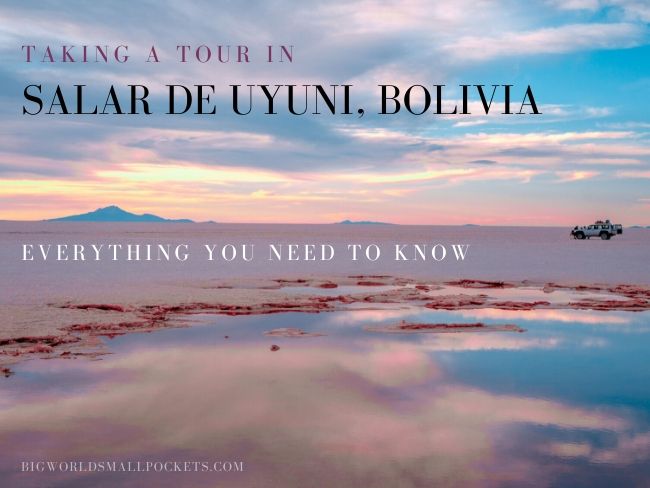
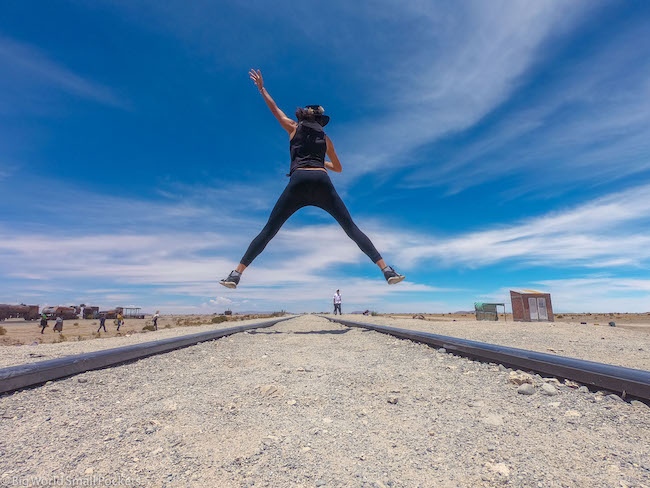
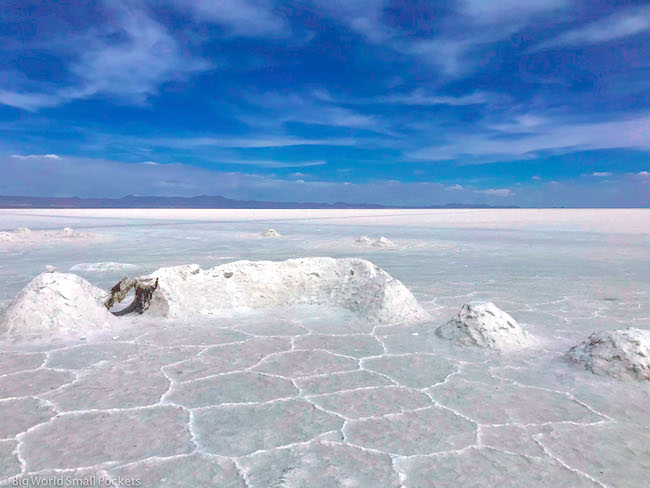
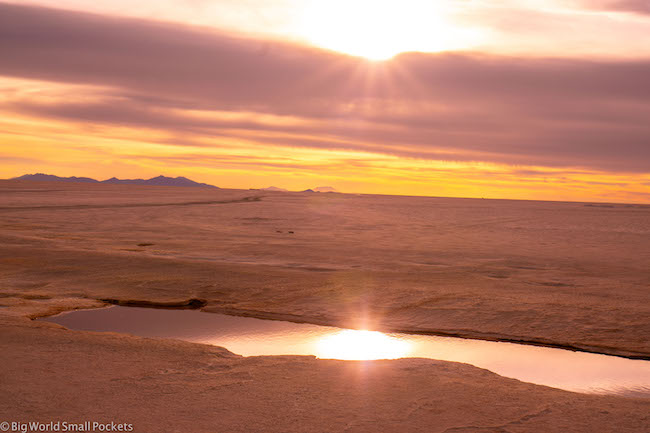
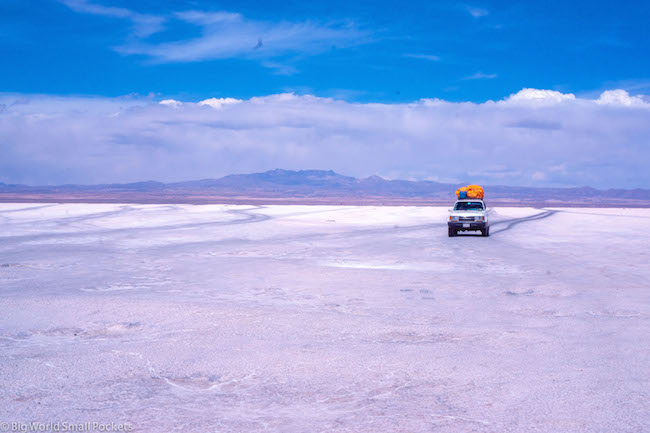
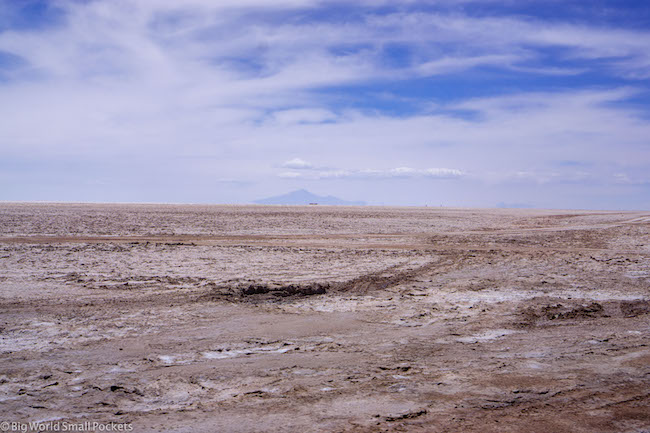

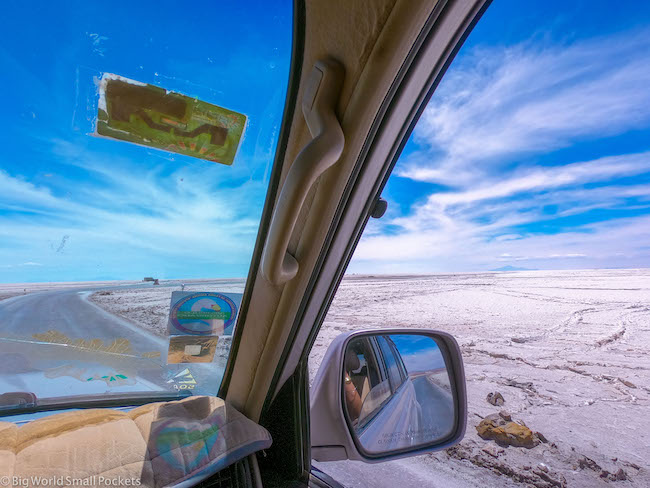
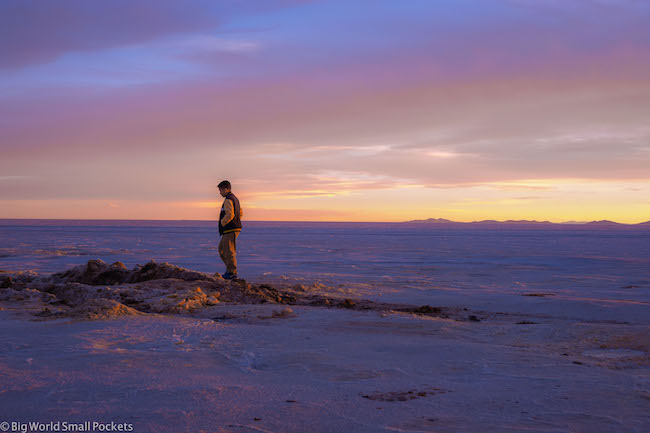
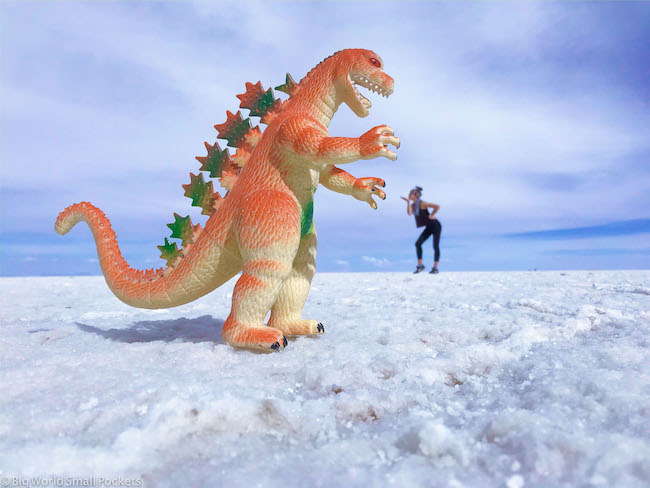
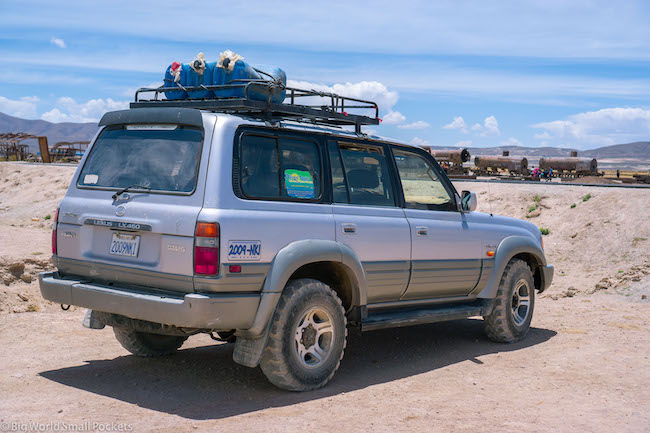
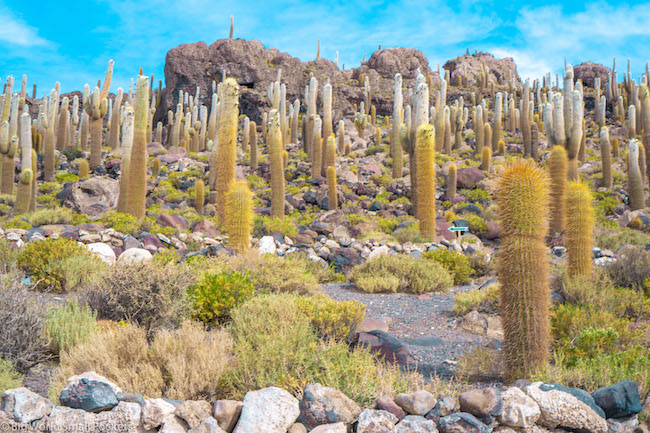
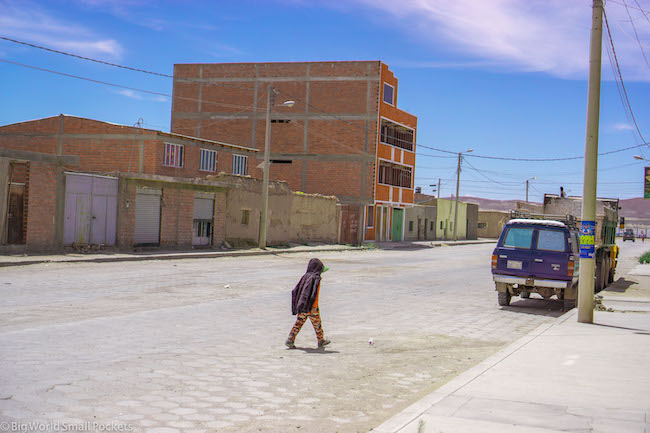
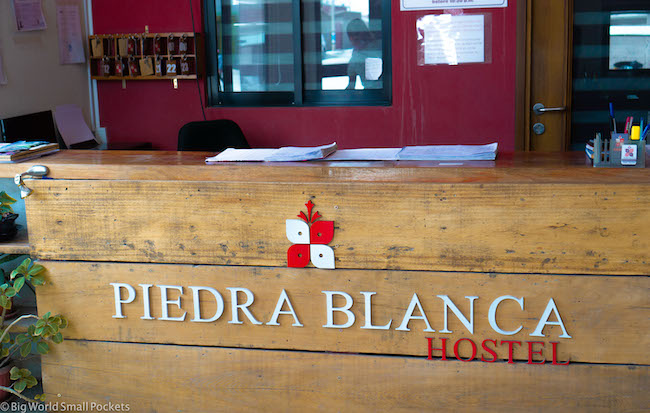
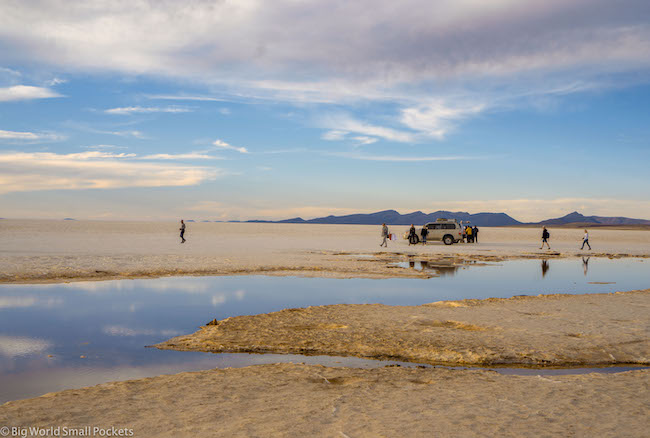
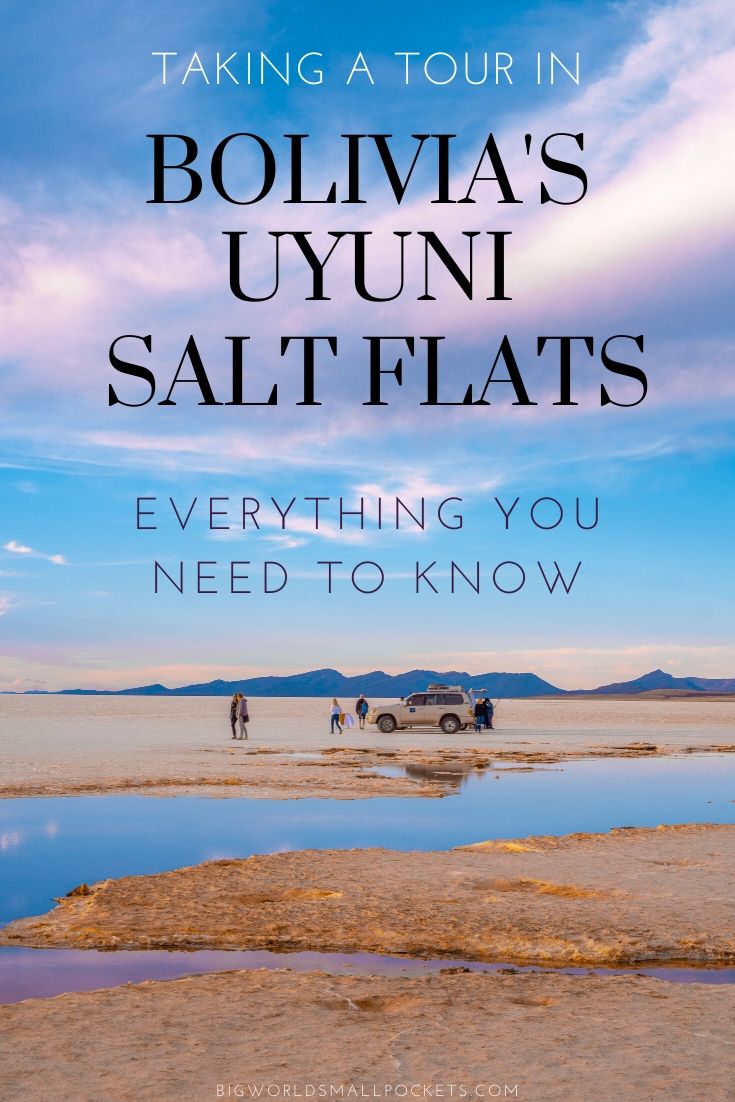
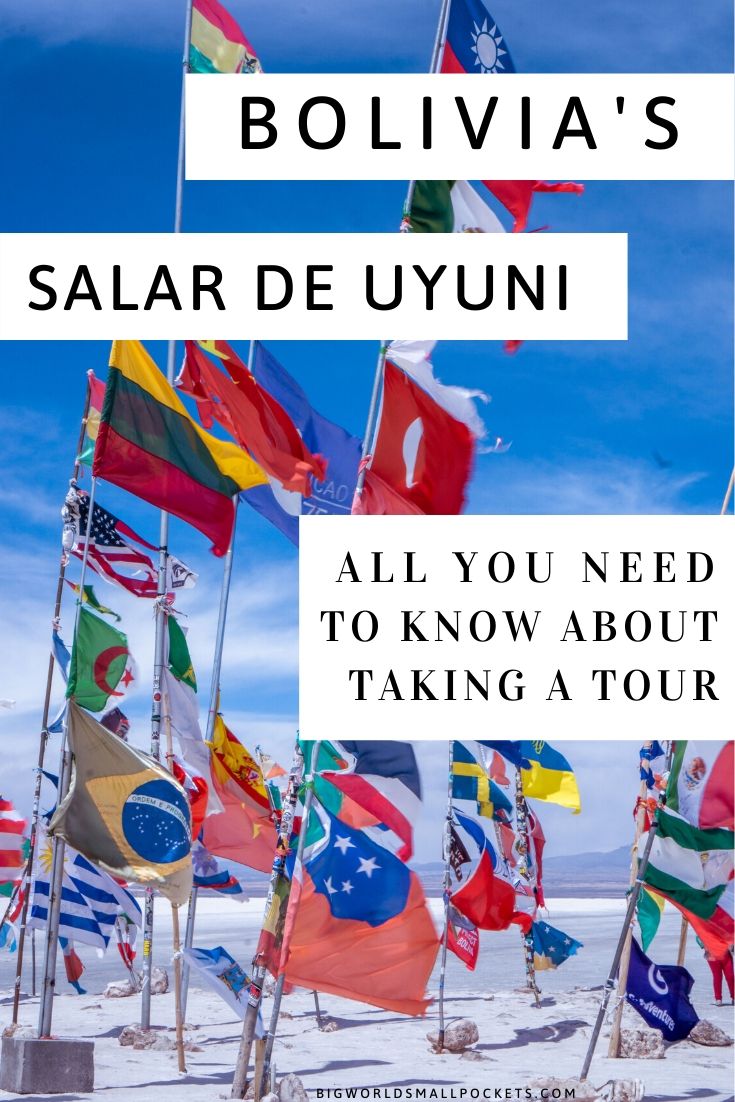
This article was quite informative and useful in helping me plan my trip next year.
Great to hear this Matt, thanks for letting me know. Happy travels, Steph 🙂
Happy I stumbled upon this article.
Detailed and so helpful as I plan my trip.
Thank you so much…keep you up the awesome job!
Thanks Sid, happy travels. Best wishes, Steph 🙂